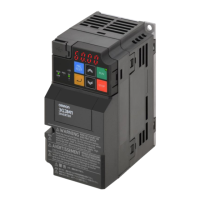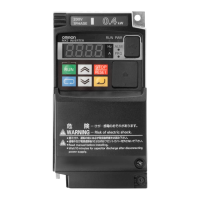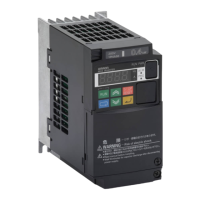Do you have a question about the Omron 3G3M1-A2075-ECT and is the answer not in the manual?
Provides instructions for the Multi-function Compact Inverter M1 Series EtherCAT Type.
Describes the installation environment and wiring methods for the inverter.
Describes EtherCAT communications and connection with Machine Automation Controller NJ/NX Series.
Describes the profiles used to control the inverter.
Describes the operation method and test run procedure for the product.
Describes basic functions such as the RUN command.
Describes how to analyze causes and take countermeasures for inverter failures.
Describes the daily maintenance and periodical inspection items.
Explains EtherCAT communications and connection with Machine Automation Controller NJ/NX Series.
Describes how to analyze causes and take countermeasures for inverter failures.
Describes the daily maintenance and periodical inspection items.
Outlines the exclusive warranty provided by Omron and limitations of liability.
Explains the meaning of signal words (WARNING, CAUTION) and symbols used for safety.
Provides essential guidelines for safe installation, transportation, operation, and maintenance.
Covers precautions for maintenance, parts replacement, product disposal, and warning labels.
Describes inverter installation guidelines, including mounting and environmental conditions.
Provides standard connection diagrams and detailed wiring instructions for main and control circuits.
Describes PDOs for real-time data transfer, including mapping settings and sync manager assignments.
Provides a step-by-step flow for performing a test run of the inverter.
Details the operation items to check before performing a test run, including installation and power-on checks.
Restores changed parameters to factory default settings and clears fault monitor data.
Describes how to select the input method for the RUN command, including terminal and EtherCAT control.
Explains various motor control methods like Dynamic Torque Vector Control, Sensorless Vector Control, and PM Motor control.
Describes position control using PG feedback, including basic operation, gain adjustment, and overtravel.
Covers motor tuning procedures, including offline auto-tuning for induction and PM motors.
Describes the restart-related functions and their operations, such as auto search and momentary power failure restart.
Describes the DC injection braking function for applying braking according to the load.
Explains the safety function that stops the motor by signals from the safety controller.
Describes how to display and reset alarms, including trip states and error codes.
Provides information for diagnosing and resolving operational issues not indicated by alarms.
Details daily and periodic inspection items, including cleaning and component checks.
Lists and describes error event codes that can be seen in Sysmac Studio.
Provides instructions for the Multi-function Compact Inverter M1 Series EtherCAT Type.
Describes the installation environment and wiring methods for the inverter.
Describes EtherCAT communications and connection with Machine Automation Controller NJ/NX Series.
Describes the profiles used to control the inverter.
Describes the operation method and test run procedure for the product.
Describes basic functions such as the RUN command.
Describes how to analyze causes and take countermeasures for inverter failures.
Describes the daily maintenance and periodical inspection items.
Explains EtherCAT communications and connection with Machine Automation Controller NJ/NX Series.
Describes how to analyze causes and take countermeasures for inverter failures.
Describes the daily maintenance and periodical inspection items.
Outlines the exclusive warranty provided by Omron and limitations of liability.
Explains the meaning of signal words (WARNING, CAUTION) and symbols used for safety.
Provides essential guidelines for safe installation, transportation, operation, and maintenance.
Covers precautions for maintenance, parts replacement, product disposal, and warning labels.
Describes inverter installation guidelines, including mounting and environmental conditions.
Provides standard connection diagrams and detailed wiring instructions for main and control circuits.
Describes PDOs for real-time data transfer, including mapping settings and sync manager assignments.
Provides a step-by-step flow for performing a test run of the inverter.
Details the operation items to check before performing a test run, including installation and power-on checks.
Restores changed parameters to factory default settings and clears fault monitor data.
Describes how to select the input method for the RUN command, including terminal and EtherCAT control.
Explains various motor control methods like Dynamic Torque Vector Control, Sensorless Vector Control, and PM Motor control.
Describes position control using PG feedback, including basic operation, gain adjustment, and overtravel.
Covers motor tuning procedures, including offline auto-tuning for induction and PM motors.
Describes the restart-related functions and their operations, such as auto search and momentary power failure restart.
Describes the DC injection braking function for applying braking according to the load.
Explains the safety function that stops the motor by signals from the safety controller.
Describes how to display and reset alarms, including trip states and error codes.
Provides information for diagnosing and resolving operational issues not indicated by alarms.
Details daily and periodic inspection items, including cleaning and component checks.
Lists and describes error event codes that can be seen in Sysmac Studio.
| Model | 3G3M1-A2075-ECT |
|---|---|
| Type | Inverter |
| Rated Output Current | 7.5 A |
| Protection Level | IP20 |
| Input Voltage | 200-240V AC |
| Output Frequency | 0.5-400Hz |
| Frequency Range | 0.5-400Hz |
| Cooling Method | Fan Cooled |
| Protection Features | Overcurrent, Overvoltage, Undervoltage, Overheat, Short circuit |
| Communication Interface | RS-485 |
| Operating Temperature | -10°C to +50°C |
| Humidity | 5 to 95% RH (non-condensing) |
| Vibration Resistance | 5.9 m/s² (0.6G) at 10-55Hz |
| Storage Temperature | -20 to 60°C (-4 to 140°F) |











